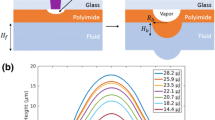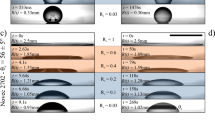Abstract
The two-fluid circular hydraulic jump, also called “rinsing flow,” is a common process where a jet of one liquid impinges upon a layer of a second liquid. We present an experimental analysis of rinsing flows using a high-speed camera and model fluids to decouple the effect of shear-thinning and elasticity. Varying the rheology of the coating fluid produced several types of instabilities at both the air–liquid interface and liquid–liquid interface. Layered “stepped jumps” and “crowning” on the rim of the jumps were both suppressed by fluid elasticity, while Saffman–Taylor fingering patterns showed strong dependence on both shear-thinning and normal stresses. In addition, the hydraulic jump evolution was quantitatively determined using a laser triangulation technique, and “recoil” of the jump front resulting from fluid elasticity was observed. Our work shows that the non-Newtonian two-fluid circular hydraulic jump is very complex, and the instabilities that arise also introduce additional complications when developing theoretical models.











Similar content being viewed by others
References
Azaiez J, Homsy GM (1994) Linear stability of free shear flow of viscoelastic liquids. J Fluid Mech 268:37–69
Batchelor L (1967) An introduction to fluid dynamics. Cambridge University Press, New York, NY
Ben Amar M, Corvera Poiré E (1999) Pushing a non-newtonian fluid in a hele-shaw cell: from fingers to needles. Phys Fluids 11:1751–1767
Bush JWM, Aristoff JM (2003) The influence of surface tension on the circular hydraulic jump. J Fluid Mech 489:229–238
Bush JWM, Aristoff JM, Hosoi AE (2006) An experimental investigation of the stability of the circular hydraulic jump. J Fluid Mech 558:33–52
Cheny JM, Walters K (1999) Rheological influences on the splashing experiment. J Non-Newtonian Fluid Mech 86:185–210
Craik ADD, Latham RC, Fawkes MJ, Gribbon PWF (1981) The circular hydraulic jump. J Fluid Mech 112:347–362
Crooks R, Boger DV (1994) Influence of fluid elasticity on drops impacting on dry surface. J Rheol 44:973–996
D’Errico G, Ortona O, Capuano F, Vitagliano V (2004) Diffusion coefficients for the binary system glycerol + water at 25 °C. a velocity correlation study. J Chem Eng Data 49:1665–1670
Edmond KV, Schofield AB, Marquez M, Rothstein JP, Dinsmore AD (2006) Stable jets of viscoelastic fluids and self-assembled cylindrical capsules by hydrodynamic focusing. Langmuir 22:9052–9056
Entov VM, Hinch EJ (1997) Effect of a spectrum of relaxation times on the capillary thinning of a filament of elastic liquid. J Non-Newtonian Fluid Mech 72:31–53
Fast P, Kondic L, Shelley MJ, Palffy-Muhoray P (2001) Pattern formation in a non-newtonian hele-shaw flow. Phys Fluids 13:1191–1212
Ghannam MT (1999) Interfacial properties of polyacrylamide solutions. J Appl Poly Sci 74:219–227
Homsy GM (1987) Viscous fingering in porous media. Ann Rev Fluid Mech 19:271–311
Hsu TT, Walker TW, Frank CW, Fuller GG (2011) Role of fluid elasticity on the dynamics of rinsing flow by an impinging jet. Phys Fluids 23:033101
Kelvin L (1871) Hydrokinetic solutions and observations. Philos Mag 42:362–377
Liang RF, Mackley MR (1994) Rheological characterization of the time and strain dependence for polyisobutylene solutions. J Non-Newtonian Fluid Mech 52:387–405
Lindner A, Bonn D, Corvera Poiré E, Ben Amar M, Meunier (2002) Viscous fingering in non-newtonian fluids. J Fluid Mech 469:237–256
Lindner A, Bonn D, Meunier J (2000) Viscous fingering is a shear thinning fluid. Phys Fluids 12:256–261
Liu X, Lienhard JH (1993) The hydraulic jump in circular jet impingement and in other thin liquid films. Exps Fluids 15:108–116
McKinley GH (2005) Visco-elasto-capillary thinning and break-up of complex fluids. In: Binding DM, Walters K (2005) Annual rheology reviews. The British Society of Rheology, Aberystwyth, Wales
McKinley G, Sridhar T (2002) Filament-stretching rheometry of complex fluids. Annu Rev Fluid Mech 34:375
Mills R (1973) Self-diffusion of normal and heavy water in the range 1−45°. J Phys Chem 77:685–688
Pan K-L, Hung C-Y (2010) Droplet impact upon a wet surface with varied fluid and surface properties. J Coll Interface Sci 352:186–193
Paterson L (1985) Fingering with miscible fluids in a hele-shaw cell. Phys Fluids 28:26–30
Orwoll RA, Chong YS (1999) In: Mark JE (1999) Polymer data handbook. Oxford University Press, New York
Rayleigh L (1914) On the theory of long waves and bores. Proc R Soc Lond A 90:324–328
Rioboo R, Bauthier C, Conti J, Voué M, De Coninck J (2003) Experimental investigation of splash and crown formation during single drop impact on wetted surfaces. Expt Fluids 35:648–652
Roisman I, Tropea C (2002) Impact of a drop onto a wetted wall: description of crown formation and propagation. J Fluid Mech 472:373–397
Rodd LE, Scott TP, Cooper-White JJ, McKinley GH (2005) Capillary break-up rheometry of low-viscosity elastic fluids. Appl Rheol 15:12–27
Roux DC, Cooper-White JJ, McKinley GH, Tirtaatmadja V (2003) Drop impact of newtonian and elastic liquids. Phys Fluids 15:S12
Saffman PG, Taylor G (1958) The penetration of a fluid into a porous medium or hele-shaw cell containing a more viscous liquid. Proc R Soc Lond A 245:312–329
Smith DE, Wu, XZ, Libchaber A, Moses E, Witten T (1992) Viscous finger narrowing at the coil-stretch transition in a dilute polymer solution. Phys Rev A 45:R2165–R2168
Stokes JR, Graham LJW, Lawson NJ, Boger DV (2001) Swirling flow of viscoelastic fluids. Part 2. Elastic effects. J Fluid Mech 429:117–153
Vander Wal RL, Berger GM, Mozes SD (2006) The splash/non-splash boundary upon a dry surface and thin fluid film. Expt Fluids 40:53–59
Vlad DH, Maher JV (2000) Tip-splitting instabilities in the channel saffman-taylor flow of constant viscosity elastic fluids. Phys Rev E 61:5439–5444
Walker TW, Hsu TT, Frank CW, Fuller GG (2012) Role of shear-thinning on the dynamics of rinsing flow by an impinging jet. Phys Fluids 24:093102
Watson E (1964) The spread of a liquid jet over a horizontal plane. J Fluid Mech 20:481–499
Acknowledgments
The authors would like to thank Professor Eric Shaqfeh and Professor Patrick Anderson at Eindhoven University of Technology for useful discussions. The authors would also like to thank LAM Research Corporation and the National Science Foundation for providing funding.
Author information
Authors and Affiliations
Corresponding author
Appendix: Cone-like jumps
Appendix: Cone-like jumps
In the previous sections, all the experiments used a jet of water to impinge on a layer of coating liquid with significantly higher viscosity (viscosity ratio ∼200). We now turn our attention to the case where the jet fluid has a higher viscosity than the coating fluid (viscosity ratio <1). Experiments were performed where the jet liquids were either a Newtonian glycerol–water (25 wt% glycerol) solution, a 0.0080 wt% xanthan gum solution, a 0.10 wt% polyacrylamide solution (molecular weight 15 × 106 g/mol), or a Boger fluid (0.005 wt% polyacrylamide molecular weight 15 × 106 g/mol and 0.24 wt% glycerol in water) impinging on water as the coating fluid. Under these lower concentrations, the density and surface tension of all the test fluids were found to be approximately equal to water (ρ j and σ j ). The viscosities of all the jet liquids were approximately \(0.003 \,\hbox{Pa}\,\hbox{s}\), making the viscosity ratio of these trials ∼0.33. However, because the shear viscosity values of these liquids were below the instrument limit of the shear and extensional rheometer, their viscosities were determined using a Cannon–Fenske glass capillary viscometer (Cannon Instrument). Because the capillary viscometer cannot accurately measure the viscosity of shear-thinning fluids, the results presented in this section are qualitative. The flow rate of the jet (U j ) was increased to compensate for the increased viscosity of the jet fluid so that the Reynolds number of the trials was the same as the previous trials. The system’s jet Reynold’s number (Re j ), jet Ohnesorge number (Oh j ), jet Weber number (We j ), and characteristic shear rate \(\dot{\gamma}\) are found to be 6,900, 5.7 × 10−3, and 1,500, respectively.
Figure 12 shows screen shots of these experiments. The most striking property of these flow profiles is that in all cases, the height of the hydraulic jumps was much higher than the previous cases when the viscosity ratio was much greater than one, because the coating liquids were not able to dissipate the inertial energy from the impinging jet. All trials reached maximum jump heights ∼5 times the diameter of the jet. Another notable feature is the “cone-like” jumps exhibited by the non shear-thinning glycerol–water fluid and the Boger fluid. For the two shear-thinning fluids, the jumps were more cylindrical-like, and peripheral jetting could be seen on the hydraulic jump rims. For the inelastic xanthan gum solution, the jetting created a “splash” and many small individual drops, while for the elastic polyacrylamide solution, the secondary drops were connected to the rim of the hydraulic jump due to elongational properties of the liquid. Similar observation was made by Roux et al. (2003) in their drop impact experiments onto a film of the same liquid, where they saw thin liquid threads connecting the upper rim of the crown and the secondary drops for Boger fluids.
Rights and permissions
About this article
Cite this article
Hsu, T.T., Walker, T.W., Frank, C.W. et al. Instabilities and elastic recoil of the two-fluid circular hydraulic jump. Exp Fluids 55, 1645 (2014). https://doi.org/10.1007/s00348-013-1645-9
Received:
Revised:
Accepted:
Published:
DOI: https://doi.org/10.1007/s00348-013-1645-9





